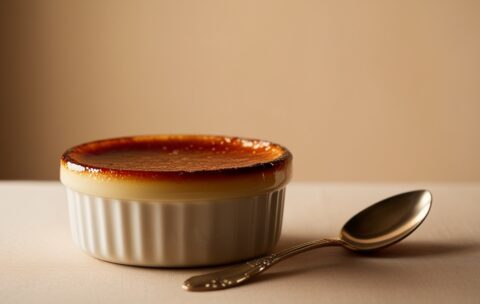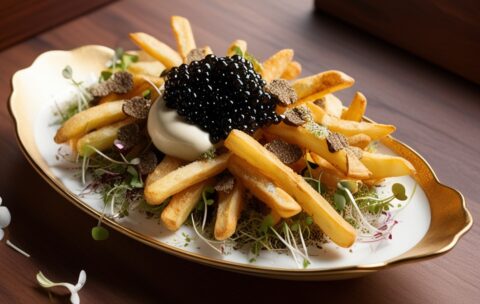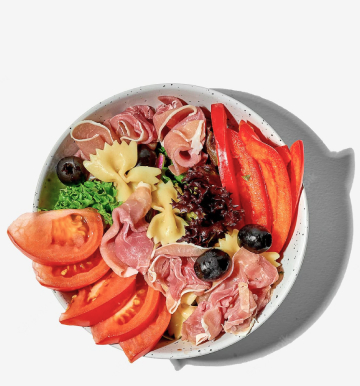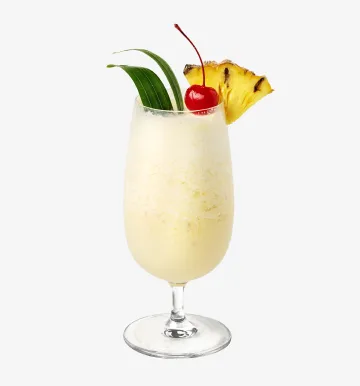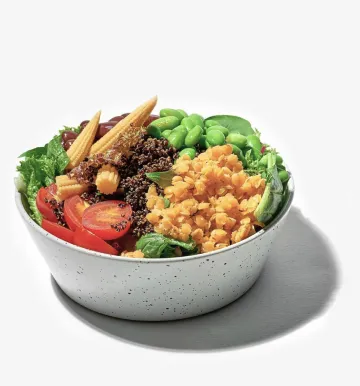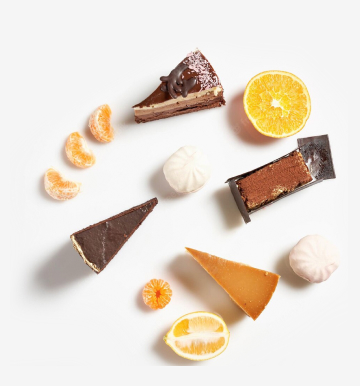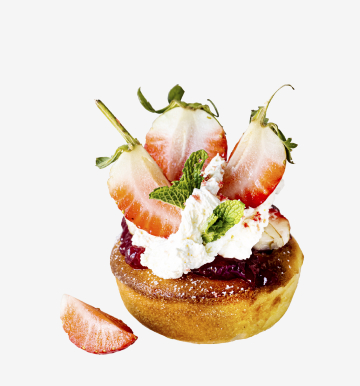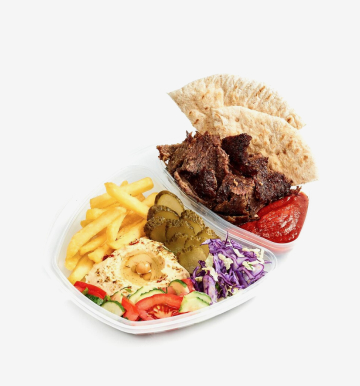Home Update 02
October 4, 2023 2025-06-05 13:04Home Update 02
Become a Home Chef
Learn to cook from scratch and master restaurant-quality meals in your own kitchen. Perfect for beginners and food lovers.

Our Top Courses
We've selected the best programs to get you started. Each course offers step-by-step lessons, hands-on recipes, and guaranteed results — even for beginners.
Crème Brûlée
5 Lessons
1.3 hour
Intermediate
What you'll learn
Custard Fundamentals (Paragraph):
You’ll discover how to create a smooth, silky custard by properly tempering egg yolks and controlling oven temperature during baking.
Flavor Infusion (List):
Selecting and preparing vanilla beans vs. extract
Balancing sugar and cream ratios for optimal richness
Incorporating subtle flavor variations (e.g., citrus zest, liqueur)
Caramelization Technique (Paragraph):
Master the process of evenly sprinkling sugar over the cooled custard and using a torch (or broiler) to achieve a perfectly caramelized, glass-like crust without burning.
Quinoa & Kale Salad
4 Lessons
2.9 hours
Intermediate
What you'll learn
How to cook quinoa perfectly every time
Proper technique for “massaging” kale to remove bitterness
Knife skills for uniformly chopping vegetables
How to whisk together a balanced lemon–tahini dressing
Tips for seasoning and customizing the salad to taste
Strategies for storing and reheating without sogginess
Caviar Pommes Frites
5 Lessons
2.5 hours
Intermediate
What you'll learn
Perfect Fry Technique: Double-fry method for ultra-crisp exterior and tender interior
Caviar Handling: Proper storage, gentle scooping, and temperature control
Sauce Preparation: Whipping crème fraîche to airy perfection and seasoning
Flavor Balancing: Harmonizing the saltiness of caviar with the richness of the fry
Plating & Garnish: Artful arrangements using micro-greens, chives, and edible flowers
Crispy Onion Rings
2 Lessons
3.8 hours
Intermediate
What you'll learn
How to choose the ideal onion variety (e.g., Vidalia, Walla Walla, or Spanish) for sweetness and structural integrity.
Techniques for slicing uniform rings to ensure even frying without undercooked centers or burnt edges.
Step-by-step instructions for creating a light, airy batter (including tempura-style options) that clings to the onion.
Methods for proper dredging, double-dipping, and maintaining batter consistency to achieve an ultra-crispy crust.
Temperature control in a frying setup—whether using a deep fryer, heavy pot, or cast-iron skillet—and how to monitor oil temperature accurately.
Tips for post-fry handling: draining rings on wire racks, timing seasoning applications, and preventing sogginess when serving.
Variations in seasoning blends (spicy paprika, garlic powder, or Parmesan) to customize flavor profiles.
Thai Mango & Green Papaya Salad
4 Lessons
2.4 hours
Intermediate
What you'll learn
Ingredient Prep: How to julienne mango and shred green papaya for optimal texture.
Dressing Mastery: Whisking the classic Thai dressing with fish sauce (or vegan substitute), lime, palm sugar, and chilies.
Texture & Balance: Layering crunchy peanuts, toasted coconut flakes, and fresh Thai basil or cilantro.
Spice Control: Adjusting heat levels with fresh bird’s-eye chilies, chili flakes, or chili paste.
Plating & Garnish: Presenting vibrant colors and garnishes—flower petals, lime wheels, and herb sprigs.
Cinnamon Sugar–Coated Churro Cake Bites
3 Lessons
4 hours
Intermediate
What you'll learn
How to bake and crumble a base cake optimized for cake bites
Ratio of cake crumbs to filling for ideal texture and binding
Frying vs. baking methods for a golden, light crust
Blending and heating cinnamon-sugar coating for crisp adhesion
Shaping techniques for uniform, crack-free bites
Serving and storage tips to keep bites fresh and crunchy
Honey Cake
6 Lessons
3.9 hours
Intermediate
What you'll learn
Ingredient Harmony
How honey interacts with flour, eggs, and spices for moist crumb.
Balancing baking soda and acidic components to ensure proper rise.
Mixing & Resting
Techniques for creaming butter, sugar, and honey without overmixing.
Importance of resting batter to develop flavor.
Baking & Texture Checks
Identifying doneness via toothpick test vs. spring-back method.
Preventing dryness through temperature control and timing.
Presentation & Serving
Simple glazing ideas and dusting techniques.
Pairing suggestions (e.g., whipped cream, fresh berries).
Crêpe Suzette
3 Lessons
3.3 hours
Intermediate
What you'll learn
Techniques for cooking crêpes evenly in a nonstick pan (temperature control, batter spread).
Steps to prepare an aromatic orange–butter sauce with fresh citrus zest and juice.
Proper method of adding liqueur and safely flambéing to develop caramelized notes.
Plating and folding options that highlight the vibrant orange sauce.
Tips for timing so crêpes remain warm and supple when served.
Ingredient substitutions (e.g., Cointreau or Grand Marnier, using mandarin or tangerine zest).
French Gateau & Entremet Principles
2 Lessons
1.3 hour
Intermediate
What you'll learn
Fundamental Structures: How to build entremets layer by layer—choosing and baking the right sponge (génoise, Joconde, biscuit cuillère), creating thin croustillant layers, and assembling mousse and bavarois tiers for height and stability.
Texture & Temperature Management: Techniques to ensure each component sets properly (e.g., mousse firmness, gelatin bloom, glaze viscosity) and how to keep layers distinct without bleeding.
Flavor Profiling & Balance: Pairing fruit purées, chocolate, nuts, and creams to achieve harmonious taste profiles. Understanding acidity, sweetness, and how to cut richness with complementary elements (fruit inserts, crunchy praline).
Advanced Finishing Techniques: Preparing and applying a smooth mirror glaze, torching velour sprays, using transfer sheets, and piping delicate decorations. Learning how to achieve a polished, professional look every time.
Assembly & Troubleshooting: Best practices for unmolding, repositioning, and storing entremets. Identifying and correcting common issues—sogginess, collapsed layers, uneven glazes.
Presentation & Plating: Strategies for cutting perfectly even slices, garnishing with textures (tuile, cocoa nibs, spun sugar), and arranging plated portions so they look as good as they taste.
Pulled Pork Sandwich
4 Lessons
3.3 hours
Intermediate
What you'll learn
Choosing the Right Cut: How to select a well-marbled pork shoulder (Boston butt) and understand why fat content matters for pulled pork.
Seasoning & Rubs: Crafting a balanced dry rub with spices and aromatics to build depth of flavor.
Cooking Methods: Techniques for both traditional smoker smoking (wood vs. charcoal), oven roasting, and slow-cooker approaches—pros and cons of each.
Temperature Control: Monitoring internal meat temperature, knowing when to wrap (the “Texas crutch”), and recognizing the “stall” point.
Shredding & Resting: Properly resting the cooked pork, shredding techniques (fork vs. claw), and keeping the meat moist.
BBQ Sauce Basics: Making a homemade barbecue sauce (vinegar-based, tomato-based, or mustard-based variations) and adjusting sweetness, acidity, and heat.
Sandwich Assembly: Choosing the ideal bun (brioche, kaiser roll, or potato roll), layering techniques to prevent sogginess, and adding complementary toppings (coleslaw, pickles, onions).
Plate Presentation & Storage: Tips for presentation (plating, garnishes) and storing any leftovers without losing texture or flavor.
Choose Your Category
Our courses are grouped by category to help you find what suits your taste. From quick dinners to gourmet desserts — start with what inspires you.



About Our Culinary Journey
We are passionate about bringing the joy of cooking to everyone. Our mission is to empower food lovers with the skills and confidence to create delicious meals at home. With expert chefs, innovative teaching methods, and a love for culinary arts, we’re here to inspire your kitchen adventures.
Our Commitment
Everyone can cook well. Our courses offer clear guidance to ensure success for all skill levels.
Community Focus
Join our foodie community. Share creations and grow in a supportive environment.
Why Choose Our Culinary Courses?
Our courses are designed to make cooking fun, accessible, and inspiring. Whether you're a beginner or a seasoned cook, our unique features will help you elevate your skills and unleash your culinary creativity.

Expert Instructors
Learn from world-class chefs with years of experience. Our instructors guide you step-by-step, sharing professional tips.

Flexible Learning
Study at your own pace, anytime, anywhere. Our online platform offers 24/7 access to lessons, so you can fit cooking into your busy schedule.

Hands-On Recipes
Practice with real recipes designed for all skill levels. From classic dishes to modern creations, you’ll master meals that impress every time.
What Our
Students Say
Hear from our happy students who have transformed their cooking skills with our courses. From beginners to seasoned cooks, our community loves sharing their success stories!
"This course completely changed how I cook! The instructors are so knowledgeable, and the lessons are easy to follow. I’m now confident making dishes I never thought I could."
Emma Johnson
"I love the flexibility of these courses. I can learn at my own pace and still feel supported. The recipes are amazing, and I’ve impressed my family with new dishes!"
Michael Chen
"The vegan cooking course was a game-changer for me. I learned so many creative ways to make plant-based meals that taste incredible. Highly recommend!"
Sophie Martinez
"The hands-on approach made learning so fun! I went from burning toast to baking artisan bread in weeks. Thank you for such an inspiring experience!"
James Carter
Discover Our Newest Culinary Courses
Get inspired by our latest additions! These exciting courses bring fresh ideas and techniques to your kitchen, perfect for food lovers eager to try something new. Browse our carousel to find your next culinary adventure.
Daiquiri
3 Lessons
59 minutes
Intermediate
What you'll learn
The origin and evolution of the Daiquiri, from early 20th-century Cuba to modern bars.
How to select and measure white rum, lime juice, and simple syrup for optimal balance.
Proper shaking technique: ice selection, shaker fill level, and pour timing.
Glassware choice and presentation tips (e.g., chilled coupe vs. Nick & Nora glass).
Simple variations (e.g., adding fruit purée or flavored syrups) while preserving the classic profile.
Spinach & Strawberry Salad
7 Lessons
3.8 hours
Intermediate
What you'll learn
How to select and prep baby spinach for optimal tenderness
Techniques for slicing and macerating strawberries to intensify sweetness
Crafting a balanced honey–balsamic vinaigrette from scratch
Layering ingredients for maximum textural contrast
Tips for plating and garnishing to elevate presentation
Strategies for make-ahead assembly without wilting
Osetra Caviar Blinis
4 Lessons
1.4 hour
Intermediate
What you'll learn
How to mix, ferment, and cook a classic buckwheat-and-wheat blini batter for the lightest possible texture.
Techniques for keeping blinis uniformly round and perfectly golden—no uneven edges or undercooked centers.
Best practices for handling and storing Osetra caviar to preserve its delicate flavor and texture.
Methods of layering crème fraîche (or sour cream) and caviar for a visually striking presentation that amplifies taste.
Pairing suggestions: which garnishes (chives, dill, lemon zest) accentuate caviar without overpowering it.
Lobster Roll with Garlic Butter
4 Lessons
3.3 hours
Intermediate
What you'll learn
How to select, buy, and cook fresh lobster meat (from boiling/steaming to picking meat).
Techniques for making flavored garlic butter (infusing with garlic, herbs, lemon zest).
Proper seasoning and temperature control to keep lobster tender and juicy.
Best practices for toasting split-top hot dog buns or brioche rolls so they hold up and absorb butter.
How to assemble and garnish a Lobster Roll (balancing textures with finely chopped celery, chives, or parsley).
Wagyu A5 Steak with Baby Potato Aioli and Demi-Glace
4 Lessons
2.3 hours
Intermediate
What you'll learn
Techniques for cooking A5 Wagyu to ideal doneness (medium-rare to rare)
How to prepare a silky baby potato aioli using sous-vide or stovetop methods
Steps to make a proper French-style demi-glace, including mirepoix sauté and red wine reduction
Plate composition strategies to showcase the steak’s marbling alongside colorful accents
Timing coordination for serving hot steak with freshly made sauces
French Gateau & Entremet Principles
2 Lessons
1.3 hour
Intermediate
What you'll learn
Fundamental Structures: How to build entremets layer by layer—choosing and baking the right sponge (génoise, Joconde, biscuit cuillère), creating thin croustillant layers, and assembling mousse and bavarois tiers for height and stability.
Texture & Temperature Management: Techniques to ensure each component sets properly (e.g., mousse firmness, gelatin bloom, glaze viscosity) and how to keep layers distinct without bleeding.
Flavor Profiling & Balance: Pairing fruit purées, chocolate, nuts, and creams to achieve harmonious taste profiles. Understanding acidity, sweetness, and how to cut richness with complementary elements (fruit inserts, crunchy praline).
Advanced Finishing Techniques: Preparing and applying a smooth mirror glaze, torching velour sprays, using transfer sheets, and piping delicate decorations. Learning how to achieve a polished, professional look every time.
Assembly & Troubleshooting: Best practices for unmolding, repositioning, and storing entremets. Identifying and correcting common issues—sogginess, collapsed layers, uneven glazes.
Presentation & Plating: Strategies for cutting perfectly even slices, garnishing with textures (tuile, cocoa nibs, spun sugar), and arranging plated portions so they look as good as they taste.
Cobb Salad
6 Lessons
2.9 hours
Intermediate
What you'll learn
How to poach or grill chicken breast for optimal juiciness
Technique for rendering and crisping bacon
Proper avocado selection and slicing without browning
Making a balanced Dijon-honey vinaigrette
Layering and plating the salad for visual appeal
Variations to adapt to dietary preferences (vegetarian, gluten-free)
Paella Valenciana
2 Lessons
3.3 hours
Intermediate
What you'll learn
History and Regional Context
Origins of Paella Valenciana and its connections to Valencian agricultural traditions.
Distinctions between classic Valencian paella, seafood paella (Paella de Mariscos), and other regional variants.
Selecting and Preparing Ingredients
Rice varieties (Bomba vs. Calasparra) and their impact on texture.
Choosing quality proteins (chicken and/or rabbit), native beans (judía verde, garrafó), olive oil, and saffron threads.
Preparing vegetables: green beans (bajoqueta), garrafó beans, fresh tomatoes, and garlic.
Cooking Techniques and Timing
Building a sofrito base: sautéing meat, vegetables, and spices to develop depth of flavor.
Proper rice-to-liquid ratio and how to incorporate stock infused with saffron.
Achieving the prized socarrat (crispy rice crust) without burning.
Adjusting heat levels for even cooking and optimal moisture absorption.
Presentation and Serving
Traditional ways to serve Paella Valenciana—family style straight from the paellera.
Garnishing options (lemon wedges, fresh parsley) to enhance aroma and appearance.
Tips for reheating and storing leftovers without compromising texture.
Tiramisu
4 Lessons
2.5 hours
Intermediate
What you'll learn
Espresso Preparation & Soaking Technique (Paragraph + List):
You will master brewing strong espresso (or concentrated coffee) and learn how to quickly dip ladyfingers to prevent soggy layers.
Selecting grind size and brew method for intense flavor
Timing the dipping process: just enough to infuse coffee without collapsing the biscuit
Balancing sugar in coffee liquid to sweeten subtly
**Mascarpone Cream Assembly (Table):
Step Key Tip
Whipping Egg Yolks & Sugar Whisk until pale ribbon stage for stability
Folding Mascarpone & Cream Use gentle motions to maintain airiness
Flavor Infusion Add a shot of coffee liqueur or vanilla
This table highlights how each stage contributes to a smooth, stable cream.
Layering & Chilling (Paragraph):
Learn to create uniform layers—alternating soaked ladyfingers and mascarpone cream—then chill for at least 4–6 hours (or overnight) to allow flavors to meld and set properly. Presentation tips include smoothing the top layer and evenly dusting cocoa powder.
Variations & Garnishes (Bullet List):
Fruit Twist: Add a layer of fresh berries or fruit compote between cream layers.
Chocolate Shavings: Sprinkle dark chocolate curls on top for visual contrast.
Alcohol Options: Use Marsala, rum, or coffee liqueur to deepen flavor.
Fattoush
5 Lessons
1.3 hour
Intermediate
What you'll learn
How to select and prepare a variety of crisp lettuces and vegetables.
Techniques for toasting or frying pita to achieve perfect crunch.
Crafting a signature sumac–lemon vinaigrette for authentic flavor.
Balancing textures: integrating greens, veggies & pita chips.
Creative add-ins: from pomegranate to za’atar for seasonal twists.
Presentation tips to serve fattoush attractively as part of a mezze spread.

